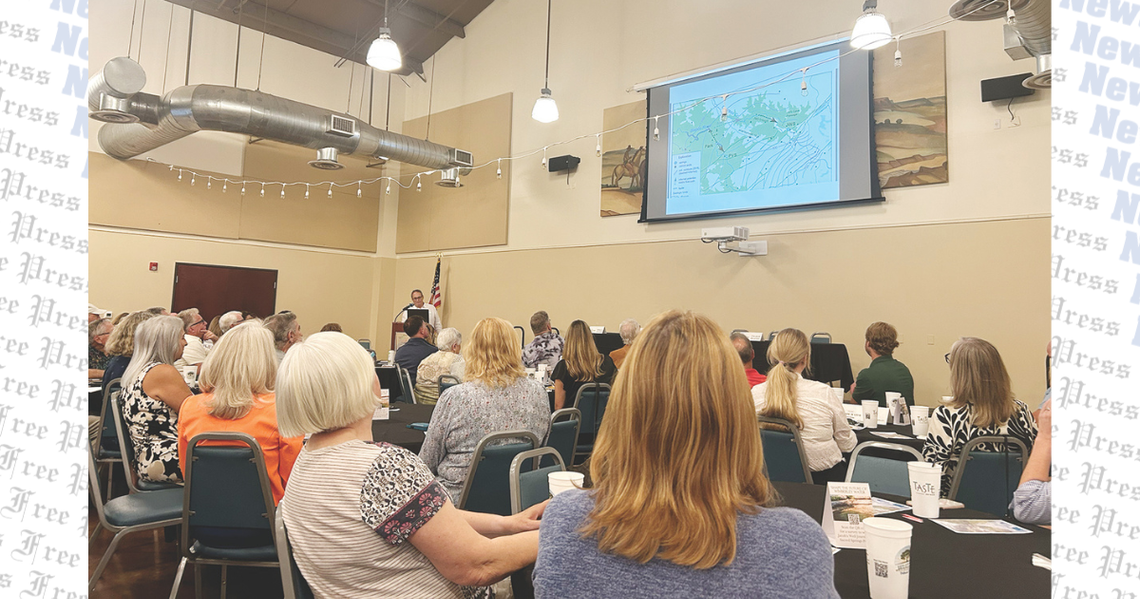WIMBERLEY — A State of the Water Luncheon was held Wednesday, June 25, at the Wimberley Community Center to discuss ongoing concerns with community members.
According to David Baker, founder and executive director of The Watershed Association, the community and its leaders prefer to not face the reality of the water in Hays County, but it cannot be avoided. The truth, he stated, is that surface water — rivers, lakes and creeks — are becoming less reliable as the temperatures continue to rise. This includes iconic resources, such as Jacob’s Well, which has been dry for nearly four years, said Baker.
This not only has an impact on the water availability, but on the economy, as for a small, tourist town, like Wimberley, a large portion of its revenue comes from those visiting for its scenery, including Cypress Creek and Blue Hole: “That’s our brand, but we’re not managing that sustainably,” Baker said.
“We’ve got almost 12 million people slated to move to this region by 2040 — none of them are bringing their water with them and we cannot grow these water supplies fast enough to keep up. Hays County is the fastest growing county in the U.S. We are projected 278% growth; 600,000 by 2050,” Baker emphasized.
According to Dr. Robert Race, executive director & chief water policy officer of The Meadows Center for Water and the Environment, Hays County would need to find 175,000 acre feet per year of water to maintain its current growth.
With this projected growth and the fact that the county needs another 17 inches of rain to reach its average, Baker continued, the importance of finding a solution is dire.
Hays Trinity Groundwater Conservation District General Manager Charlie Flatten noted that many community members are aware that this is a need and are acquiring rainwater for their usage.
“Should we bring in a big water line to solve this,” asked Baker. “Two lines planned for Wimberley regional has the GBRA's Western Canyon [Water Treatment Plant] that would bring water, about 875,000 gallons … Well the pros are an alternate to the Trinity [Aquifer], helps reduce drawdown and pressure, if we can cap those wells. [It] supports long term municipal demand … [but] it increases wastewater discharge. Once you bring that water in, you can’t do land allocation or try to put it in the river.”
Currently, Baker shared that a Warm Water Resiliency Plan is being written, which is a road map for the future, including land use, water use, community resilience, economic and housing strategies and regional collaboration.
In addition to this plan, Flatten discussed bills in the legislature. One of which would create a nominal production fee on nonexempt wells to “create a sustainable revenue for long term water,” said Flatten. “It would also provide cost incentives to developers and builders to incorporate water conservation systems in new developments.”
In the meantime, all speakers noted that Wimberley, Woodcreek and Hays County are doing their part in searching for a solution for the lack of water, as recently, the three signed an interlocal agreement to implement a collaborative water and wastewater planning effort. As previously reported by the News-Dispatch, the parties have a history of working together on important issues and currently participate in the management of the Blanco Cypress Creek Watershed Protection Plan.
“All of these places coming together will be, in my opinion, extremely beneficial,” said Hays County Commissioner Precinct 3 Morgan Hammer, stating that plans could begin as soon as this summer.










